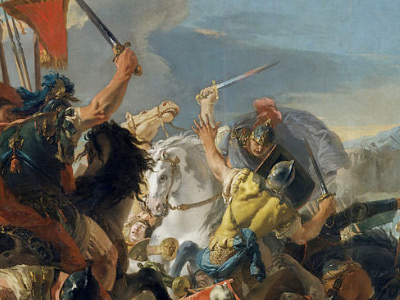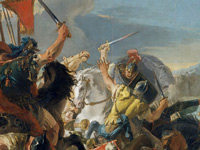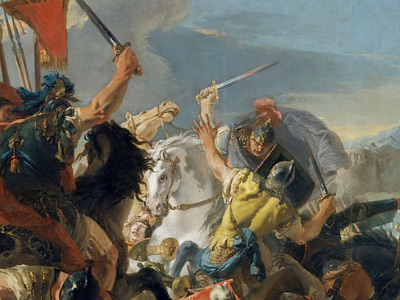Battle of Vercellae (101 BC)

The Battle of Vercellae, or Battle of the Raudine Plain, in 101 BC was the Roman victory of Consul Gaius Marius over the invading Celto-Germanic tribe of the Cimbri near the settlement of Vercellae in Cisalpine Gaul.
The Cimbri had invaded northern Italy and repeatedly defeated the 20,000 men strong army of consul Quintus Lutatius Catulus. After defeating the Teutones at Aquae Sextiae, Marius arrived with 32,000 soldiers to reinforce Catulus and defeat the Cimbri. The two armies met on the Raudian plain (or plain of Vercellae) and the Romans won a total victory over the invaders.
Much credit for this victory has been given to the actions of Proconsul Catulus' legate, Lucius Cornelius Sulla who led the Roman and allied Italian cavalry. The Cimbri were virtually wiped out, with the Romans claiming to have killed 65,000–160,000 and captured 60,000, including large numbers of women and children.
Background
In 101 BC the Cimbri invaded Italy through the Eastern Alpine passes. No enemy army had invaded Roman Italy since Hannibal in the Second Punic War. Roman Consul Catulus, who had only 20,000 men to guard all of the passes, was forced to retreat before the Cimbrians. Catulus mounted a surprise attack on the Cimbric camp and was afterwards able to retreat to the north Italian plain. The Romans retreated to the Adige river, built fortifications on both banks and a bridge between the two positions, to fight on the defensive against Cimbric attacks.
After the Cimbrians had dammed the river and sent heavy objects downriver to destroy the bridge, many of the Romans panicked and abandoned their second defensive position as well. Catulus retreated along with his men. Some of his cavalry retreated all the way to Rome. A significant Roman force stayed behind to hold the Adige line but were defeated by the Cimbrians, who attacked and captured the fort.
Catulus retreated to his third defensive position south of the Po. The Cimbrians had defeated him twice and now proceeded to sack Cisalpine Gaul. They did not pursue the Romans, as they intended to settle in northern Italy.
Having defeated the Teutones at Aquae Sextiae and having returned to Rome without his army, consul Gaius Marius regathered his men and marched to the Po.
Prelude
After merging Catulus' army with his own, Marius began negotiations with the Cimbrians, who demanded land to settle on. Marius refused and instead sought to demoralize the Cimbri by parading captured Teuton nobles before them. Neither side genuinely sought negotiations, the Romans not intending to hand over their land to foreign invaders and the Cimbri believing themselves to be on brink of a successful peace after their recent victories over the Romans.
Over the next few days the armies maneuvered against each other, the Romans initially refusing to give battle. Marius chose the optimal location for the battle, an open plain near Vercelli. The Roman consul then met with the Cimbri leader Boiorix to agree on the time of battle. Marius had 32,000 men and Catulus 20,300.
Battle
The 15,000 strong Cimbric cavalry rode onto the battlefield. Behind them came the infantry. According to Plutarch, Marius made a final sacrifice to the gods.
"Marius washed his hands, and lifting them up to heaven, vowed to make a sacrifice of 100 beasts should victory be his".
The Romans got into position first, therefore the sun would be reflecting off the Roman's armor. The Cimbri thought the sky was on fire. Sensing their sudden anxiety, the Romans attacked. The Cimbri cavalry were taken completely by surprise by the Roman cavalry. The Cimbri were forced back. The Roman legionaries then engaged the Cimbri infantry. The Cimbri were very unnerved by this. Plutarch writes that the Romans now were able to slaughter the enemy with ease. Boiorix and his noblemen made a last stand in which they were all killed. The Romans had won a complete and stunning victory.
Aftermath
The victory of Vercellae, following close on the heels of Marius' destruction of the Teutones at the Battle of Aquae Sextiae the previous year, put an end to the Celto-Germanic threat on Rome's northern frontiers. The Cimbri were virtually wiped out, with the Romans claiming to have killed 120,000 and captured 60,000, including large numbers of women and children. Children of the surviving captives may have been among the rebelling gladiators in the Third Servile War.
Politically, this battle had great implications for Rome as well. It marked a continuation in the rivalry between Marius and Sulla, which would eventually lead to the first of Rome's great civil wars. As a reward for their gallant service, Marius granted Roman citizenship to his Italian allied soldiers, without consulting or asking permission from the Senate first. When some senators questioned this action, he would claim that in the heat of battle he could not distinguish the voice of Roman from ally from the voice of the law. Henceforth all Italian legions would be Roman legions. This was also the first time a victorious general had openly defied the Senate and it would not be the last; in 88 BC, Sulla, in defiance of both the Senate and tradition, would lead his troops into the city of Rome itself. And Julius Caesar, when ordered by the Senate to lay down his command and return to Rome to face misconduct charges, would instead lead one of his legions across the Rubicon in 49 BC. This would mark the start of the civil war between himself and senatorial forces under Pompey which would effectively end the Roman Republic The Roman Republic was a form of government of Rome and the era of the classical Roman civilization when it was run through public representation of the Roman people. Beginning with the overthrow of the Roman Kingdom (traditionally dated to 509 BC) and ending in 27 BC with the establishment of the Roman Empire, Rome's control rapidly expanded during this period - from the city's immediate surroundings to hegemony over the entire Mediterranean world..
The Roman Republic was a form of government of Rome and the era of the classical Roman civilization when it was run through public representation of the Roman people. Beginning with the overthrow of the Roman Kingdom (traditionally dated to 509 BC) and ending in 27 BC with the establishment of the Roman Empire, Rome's control rapidly expanded during this period - from the city's immediate surroundings to hegemony over the entire Mediterranean world..
HISTORY

RESOURCES
This article uses material from the Wikipedia article "Battle of Vercellae (101 BC)", which is released under the Creative Commons Attribution-Share-Alike License 3.0.
© Stories Preschool. All Rights Reserved.










